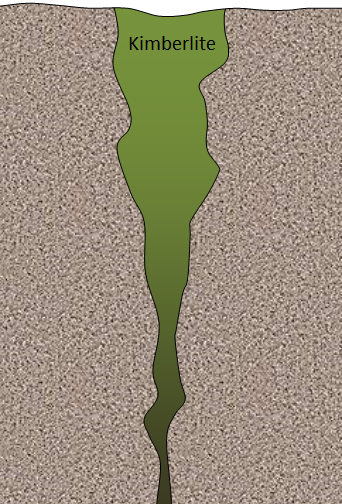142 Summary — Physical Geology – 2nd Edition

Explain why nickel deposits are associated only with mafic magma and not with intermediate or felsic magma?
What is the composition of the black smoke in a black smoker, and how does that relate to a volcanogenic massive sulphide deposit?
How might an epigenetic gold deposit be related to a porphyry deposit?
Oxidation and reduction processes are important to both banded iron formation deposits and unconformity-type uranium deposits. Explain the role in each case.
A typical kimberlite in northern Canada may look something like Figure B. In this case, the diameter at the surface is around 500 m, and the total depth is about 2,500 m. Bearing in mind that an open pit cannot typically be any deeper than it is wide, what mining method(s) might be most applicable to a deposit of this type?

What mineral is typically responsible for acid rock drainage around mine sites, and why is this mineral so common in this setting?
Explain why glaciofluvial gravel is more suitable than till as a source for aggregate.
The raw material for making cement is lime (CaO), and this is typically produced by heating limestone (mostly CaCO3) to about 1,000°C. Why is this an environmental issue?
Name some important industrial minerals that form in an evaporite setting.
If organic matter accumulates at an average rate of 1 mm per year, and if 10 m of organic matter is required to make 1 m of coal, how long must a swampy environment remain stable and wet in order to form a 1.5 m coal seam?
What are the ideal characteristics of petroleum source rocks and petroleum reservoir rocks?
How deep must the source rocks be buried to produce oil?
Why is shale gas an unconventional reserve, and how is it recovered? What are some of the environmental issues associated with that process?
If you were sampling glacial deposits to search for kimberlites, why would you be advised to look for kimberlite indicator minerals rather than diamonds?
Media Attributions
- Figure A (left): “Spiral CFL Bulb 2010-03-08 (white black)” © Sun Ladder. CC BY-SA.
- Figure A (right): “Elektronstarterp” © Anton. CC BY-SA.
- Figure B: © Steven Earle. CC BY.
<!– pb_fixme –>
<!– pb_fixme –>

